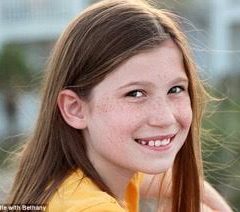March 8, 2017 | Stephen Fine, Founder and President
Childhood Melanoma
Melanoma is truly an awful disease. Whether an afflicted adult ultimately survives an advanced case on not, he or she will suffer significant physical and emotional trauma throughout the entire exhaustive process. Just imagine a child having to experience that. Children, who are just getting started in the world, should never have to suddenly face their own mortality.
Unfortunately, melanoma doesn’t care. And that, along with a greater need for skin cancer awareness and education, is why we continue to lose countless brave pre-teens and adolescents. Among them are the late Jillian Beach, 15 and Bethany Cobb, 11.


It’s our determined mission to do everything possible to help prevent children and their families from having to deal with this; the worst form of skin cancer. With that in mind..
Some Information on Childhood Melanoma
Melanoma can develop on anyone at any age, but there are some differences in the disease between adults and juveniles. To be more specific, we’ll turn to these quotes from the cited Dermnet of New Zealand material linked below:
Regarding children from birth up to age 10
“Superficial spreading melanoma is less common in younger children and melanoma has the ABCDE criteria in 40% of cases. Melanoma in young children is more commonly amelanotic (red coloured), nodular, and tends to be thicker at diagnosis than in older children and adults.” *
It’s also important to remember that melanoma may present itself as pink or flesh-colored. This can be deceiving when looking for darker-toned moles and blemishes on light skin.
Dermnet continues with youths 11 to 18
“Melanoma in older children appears similar to melanoma in adults; it presents as a growing lesion that looks different from the child’s other lesions. Most are pigmented. About 60% have the ABCDE criteria…”*
We want to add that 40% is the rarer, yet more lethal, nodular melanoma. To learn more about that version, please click here.
Once melanoma is diagnosed, its potential treatment is chosen by doctors from the same pool of options used for anyone; regardless of age.
Please note that within the skin cancer community, “ABCDE” is a linguistic device used to help people remember what to look for in moles and other skin blemishes. The letters stand for the following: A= Asymmetry, B= Border, C= Color, D= Diameter, E= Evolving.
We’ve saved perhaps the most important item for last, as that way it’s more likely to be remembered. It’s so vital because everything you’ve read above can be completely avoided- if you just keep this one simple thing in mind:
The cure rate for melanoma detected early enough hovers around 100%.
In those instances, the initial (or follow-up) biopsy, (a quick procedure to remove the impacted tissue performed right in a doctor’s office) is actually the cure itself.
That means there would be no need at all for chemotherapy or radiation treatments.
In the coming weeks, you can expect to read more from us on melanoma right here on this blog. We ask only that you apply what you learn, and spread the information on to others.
It is no understatement to that if you do, you could very easily save a life.
Additional Sources: Dermnet of New Zealand
